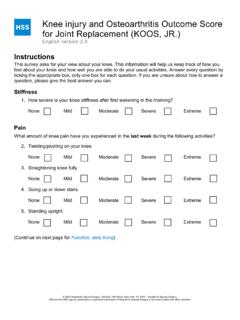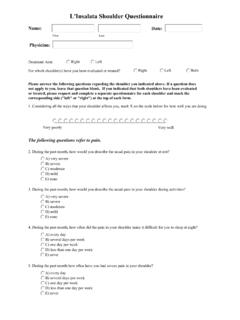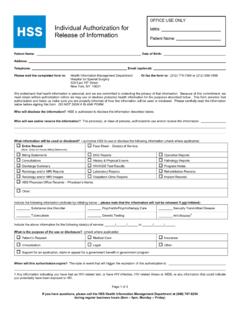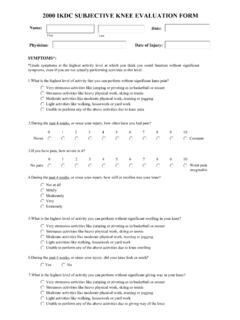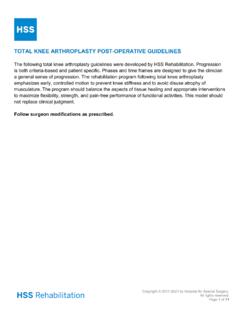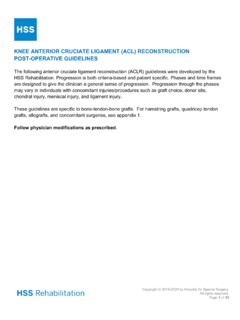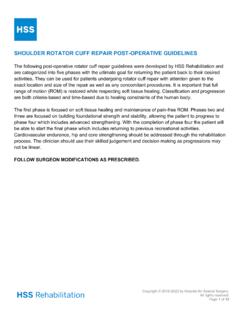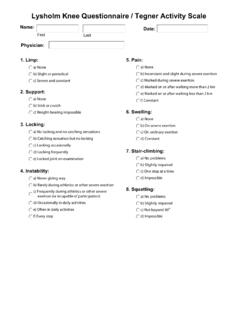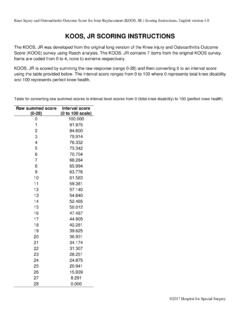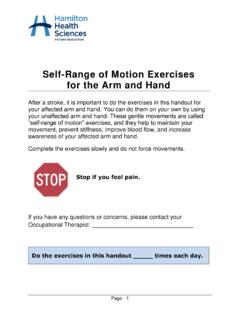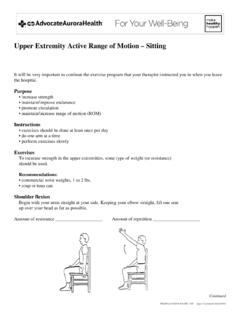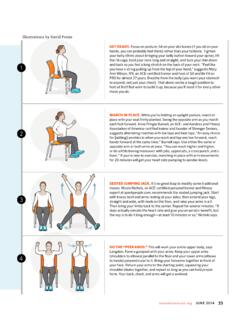Transcription of WRIST DISTAL RADIUS FRACTURE POST-OPERATIVE …
1 Copyright 2019-2021 by Hospital for Special Surgery. All rights reserved. Page 1 of 9 WRIST DISTAL RADIUS FRACTURE POST-OPERATIVE GUIDELINES The following POST-OPERATIVE DISTAL RADIUS FRACTURE guidelines were developed by HSS Rehabilitation. Progression is both criteria-based and patient specific. Phases and time frames are designed to give the clinician a general sense of progression. The rehabilitation program following open reduction internal plate fixation emphasizes early, controlled motion to prevent stiffness and to avoid disuse atrophy of musculature. The program should balance management of prior deficits, tissue healing and appropriate interventions to maximize flexibility, strength, and pain-free performance of functional activities. This model should not replace clinical judgment. Follow surgeon modifications as prescribed. Copyright 2019-2021 by Hospital for Special Surgery. All rights reserved. Page 2 of 9 WRIST DISTAL RADIUS FRACTURE POST-OPERATIVE GUIDELINES Phase 1.
2 Protective (Weeks 0-2) PRECAUTIONS Observe non-weight bearing status Avoid tight grasping, lifting, carrying, pushing, pulling No passive range of motion (PROM) of WRIST and forearm Avoid sharp increase in pain during exercises Be alert for signs and symptoms of the following and report to surgeon if present o Complex regional pain syndrome (CRPS) o Infection o Pain over FRACTURE site(s) with digit motion, extensor indicis proprius (EIP), extensor pollicis longus (EPL), flexor pollicis longus (FPL) o Abnormal sensation ASSESSMENT Functional status level of hand use in daily activity (interview, observation) o Quick Disabilities of the Arm, Shoulder and Hand Score (QuickDASH) o Consider administering Patient Specific Functional Scale (PSFS) Numeric Pain Rating Scale (NPRS) Orthotic fit and position o WRIST 0 -20 extension o Thumb and DISTAL palmar crease clearance Screen active range of motion (AROM) of proximal upper extremity joints (shoulder, elbow) Screen AROM of digits, including thumb o Fingers: consider measure of individual finger joint AROM if marked limitation present as well as fingertip to DISTAL palmar crease (DPC) distance o Thumb: consider formal goniometric measurement of IP and MCP joint AROM if limited; as well as Kapandji score for opposition AROM of bilateral wrists (flexion/extension, radial/ulnar deviation) and forearms (pronation, supination) Edema measurement options include: o WRIST circumferential measurement o DISTAL palmar crease circumferential measurement o Finger circumferential gauge Copyright 2019-2021 by Hospital for Special Surgery.
3 All rights reserved. Page 3 of 9 TREATMENT RECOMMENDATIONS Patient education o Nature of the condition and expectations for course of treatment o Orthotic wearing schedule and care o Wound care/pin care as per surgeon protocol o Management of pain and edema o Scar management: instruct patient to initiate gentle massage when incision is dry and closed o Activity modification to manage pain o Movement strategies for performing activities of daily living (ADL) while observing precautions o Light hand use o Home exercise program o Light soft tissue self-mobilization Manual techniques o Light soft tissue mobilization o Edema management (ice, elevation, overhead active digit motion) Therapeutic exercise techniques o AROM and PROM of fingers and thumb o Isolated AROM and light active assisted range of motion (AAROM) of WRIST (flexion/extension, radial/ulnar deviation) without compensation by extensor digitorum communis (EDC) for extensor carpi radialis brevis/longus (ECRB/L) and extensor carpi ulnaris (ECU)
4 O AROM of forearm pronation and supination with elbow at 90 flexion at side o Consider light AAROM for forearm if no concomitant triangular fibrocartilage complex injury Functional use o Consider functional activities in clinic according to patient-specific goals, especially if patient appears reluctant or reports difficulty with incorporating hand into appropriate ADL and instrumental activities of daily living (IADL) CRITERIA FOR ADVANCEMENT Surgeon clearance for PROM WRIST and forearm EMPHASIZE Digit and thumb range of motion (ROM) Edema management Isolated WRIST and forearm ROM Light hand use Minimal to no sling use Copyright 2019-2021 by Hospital for Special Surgery. All rights reserved. Page 4 of 9 WRIST DISTAL RADIUS FRACTURE POST-OPERATIVE GUIDELINES Phase 2: Mobilization (Weeks 3-8) PRECAUTIONS Observe non-weight-bearing status Avoid tight grasping, lifting, carrying, pushing, pulling Avoid sharp increase in pain during exercises Be alert for signs and symptoms of the following and report to surgeon if present o CRPS o Infection o Pain over FRACTURE site(s) with digit motion, EIP, EPL, FPL Remain alert for tendon rupture/fraying over FRACTURE site most commonly EPL o Abnormal sensation ASSESSMENT Functional status level of hand use in daily activity (interview, observation) o QuickDASH o Consider administering PSFS NPRS Orthotic fit and position (for duration of splint wear as per surgeon orders) o WRIST 0 -20 extension o Thumb and DISTAL palmar crease clearance Monitor AROM of proximal upper extremity joints (shoulder, elbow) Monitor AROM of digits including thumb o Fingers.
5 Consider formal measurement of fingertip to DPC distance if limited o Thumb: consider formal goniometric measurement of IP and MCP joint AROM if limited; as well as Kapandji score for opposition AROM of WRIST (flexion/extension, radial/ulnar deviation) and forearm (pronation, supination) Edema measurement options include: o WRIST circumferential measurement o DISTAL palmar crease circumferential measurement o Finger circumferential gauge Assess for intrinsic versus extrinsic tightness Joint position sense if proprioceptive deficit is suspected ( , discrepancy is noted between AROM and functional use) Copyright 2019-2021 by Hospital for Special Surgery. All rights reserved. Page 5 of 9 TREATMENT RECOMMENDATIONS Patient education o Orthotic wearing schedule and care (for duration of splint wear as per surgeon orders) o Management of pain and edema o Scar management o Explanation of differential role of AROM and PROM, and the importance of both o Appropriate functional use o Home exercise program o Light soft tissue self-mobilization Manual techniques o Light soft tissue mobilization o Edema management (elevation, overhead active digit motion, compression sleeve and/or glove; self-adherent elastic wrap; elastic adhesive tape).
6 Consider orthosis remold as edema decreases o Scar management (gentle massage around and over dry and closed incision - steristrips should be removed manually if they are still on after 10-14 days; consider silicone scar pad or scar elastomer if appropriate) o Joint mobilization if clinically indicated, after clearing for contraindications, therapists skilled in manual techniques can perform mobilizations to improve ROM when there is continued joint stiffness Therapeutic exercise techniques o AROM and PROM of fingers and thumb o Initiate PROM exercises for WRIST and forearm when FRACTURE healing and surgeon permits o Continue WRIST and forearm AROM; should also commence multiplane ROM exercises o Intrinsic/extrinsic stretching o Proprioception training as appropriate with respect to weightbearing status Functional use o Continue functional activities in clinic according to patient-specific goals CRITERIA FOR ADVANCEMENT Surgeon confirmation of FRACTURE healing with clearance to initiate strengthening o Note: select surgeons may delay strengthening to 12 weeks post-operatively or ask that no formal strengthening program be implemented altogether EMPHASIZE Edema management Digit ROM WRIST and forearm ROM Appropriate hand use during ADL Copyright 2019-2021 by Hospital for Special Surgery.
7 All rights reserved. Page 6 of 9 WRIST DISTAL RADIUS FRACTURE POST-OPERATIVE GUIDELINES Phase 3: Strengthening (Weeks 9- 12) PRECAUTIONS Avoid overexertion/introducing too much resistance before patient is ready Avoid sharp increase in pain during exercises Be alert for signs and symptoms of the following and report to surgeon if present o CRPS o Infection o Pain over FRACTURE site(s) with digit motion, EIP, EPL, FPL Remain alert for tendon rupture/fraying over FRACTURE site most commonly EPL o Abnormal sensation ASSESSMENT Functional status level of hand use in daily activity (interview, observation) o QuickDASH o Consider administering PSFS NPRS Monitor AROM of proximal upper extremity joints (shoulder, elbow) Monitor AROM of digits including thumb o Fingers: consider formal measurement of fingertip to DPC distance if limited o Thumb: consider formal goniometric measurement of IP and MCP joint AROM if limited; as well as Kapandji score for opposition AROM/PROM of WRIST (flexion/extension, radial/ulnar deviation) and forearm (pronation, supination) Edema measurement options include: o WRIST circumferential measurement o DISTAL palmar crease circumferential measurement o Finger circumferential gauge Assess for intrinsic versus extrinsic tightness Grip strength Pinch strength Manual muscle testing if indicated for upper extremity strength Joint position sense if proprioceptive deficit is suspected ( , if discrepancy is noted between AROM and functional use) Copyright 2019-2021 by Hospital for Special Surgery.
8 All rights reserved. Page 7 of 9 TREATMENT RECOMMENDATIONS Patient education o Management of pain and edema o Scar management o Explanation of differential role of AROM and PROM, and the importance of both o Explanation of importance of gradual increase in resistance to avoid inflammatory reaction o Home exercise program add strengthening and flexibility as needed o Appropriate functional use: importance of integrating hand use in daily activity for automatic, multiplanar movements o Light soft tissue self-mobilization Manual techniques o Light soft tissue mobilization o Joint mobilization if clinically indicated, after clearing for contraindications, therapists skilled in manual techniques may perform mobilizations to improve ROM when there is continued joint stiffness o Edema management (elevation, overhead active digit motion, compression sleeve and/or glove; self-adherent elastic wrap; elastic adhesive tape) o Scar management (gentle massage around and over dry and closed incision.)
9 Consider silicone scar pad or scar elastomer if appropriate) Therapeutic exercise techniques o AROM and PROM of fingers and thumb o Continue PROM exercises for WRIST and forearm when FRACTURE healed/surgeon permits o Continue WRIST and forearm AROM and multiplane ROM exercises o Intrinsic/extrinsic stretching o Strengthening exercises for digits/ WRIST /forearm when FRACTURE healed and surgeon permits o Closed kinetic chain exercises ( , wall push-ups, putty flatten) o Proprioception training, as appropriate Functional use o Continue functional activities in clinic according to patient specific goals, especially if patient appears reluctant or reports difficulty with incorporating hand into appropriate ADL or IADL Other o Consider static progressive splinting for persistent stiffness of forearm, WRIST , or fingers o Consultation with performance specialist if returning to high level sports activities CRITERIA FOR DISCHARGE Functional ROM or plateaued ROM Functional grip/pinch strength or plateaued grip/pinch strength Resumption of daily, work, and recreation activity Copyright 2019-2021 by Hospital for Special Surgery.
10 All rights reserved. Page 8 of 9 EMPHASIZE Edema management WRIST and forearm ROM and flexibility Gradual strengthening Full hand and upper extremity use in ADL Copyright 2019-2021 by Hospital for Special Surgery. All rights reserved. Page 9 of 9 WRIST DISTAL RADIUS FRACTURE POST-OPERATIVE GUIDELINES References Daud AZ, Yau MK, Barnett F, Judd J, Jones RE, Nawawi RF. Integration of occupation based intervention in hand injury rehabilitation: a randomized controlled trial. J Hand Ther. 2016 Jan 1; 29(1): 30-40. Gately CT. DISTAL RADIUS fractures. In: Cioppa-Mosca J, Cahill JB (eds.) Post-Surgical Guidelines for the orthopedic clinician. Mosby Elsevier, St. Louis; 2006: 109-115. Jiang JJ, Phillips CS, Levitz SP, Benson LS. Risk Factors for complications following open reduction internal fixation of DISTAL RADIUS fractures. J Hand Surg. 2014 Dec 1; 39(12): 2365-2372. Karagiannopoulos C, Michlovitz, S. Rehabilitation strategies for WRIST sensorimotor control impairment: From theory to practice.
